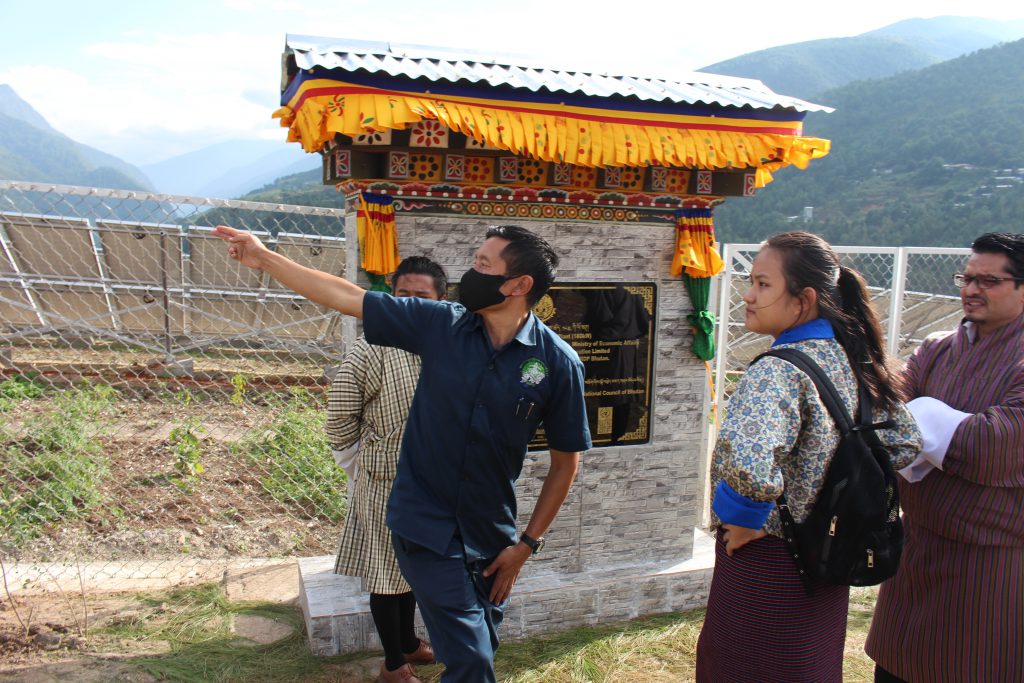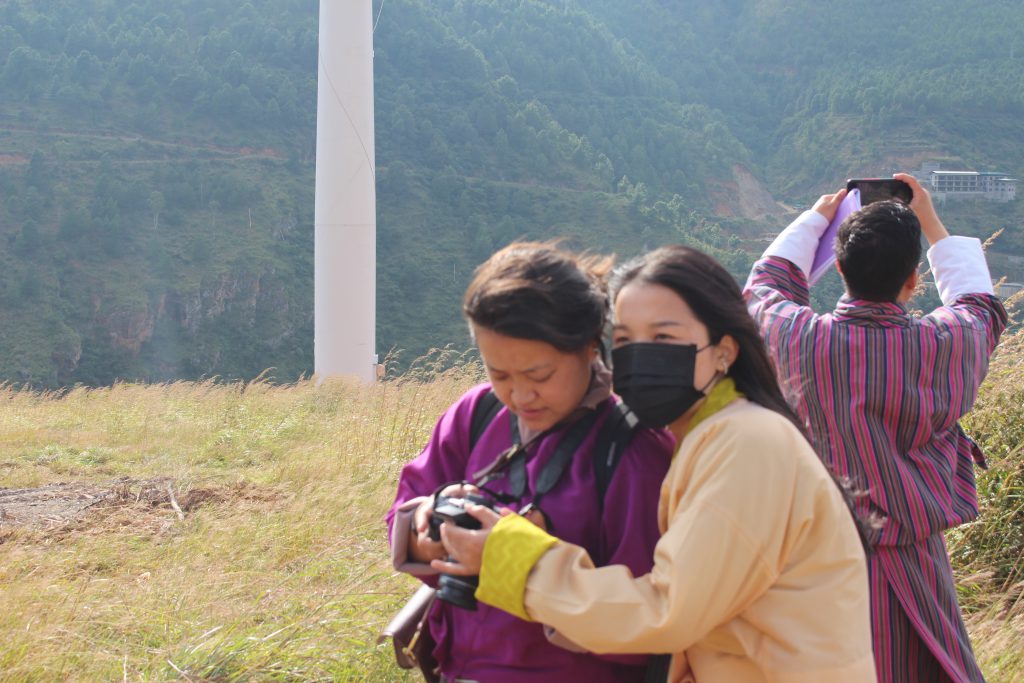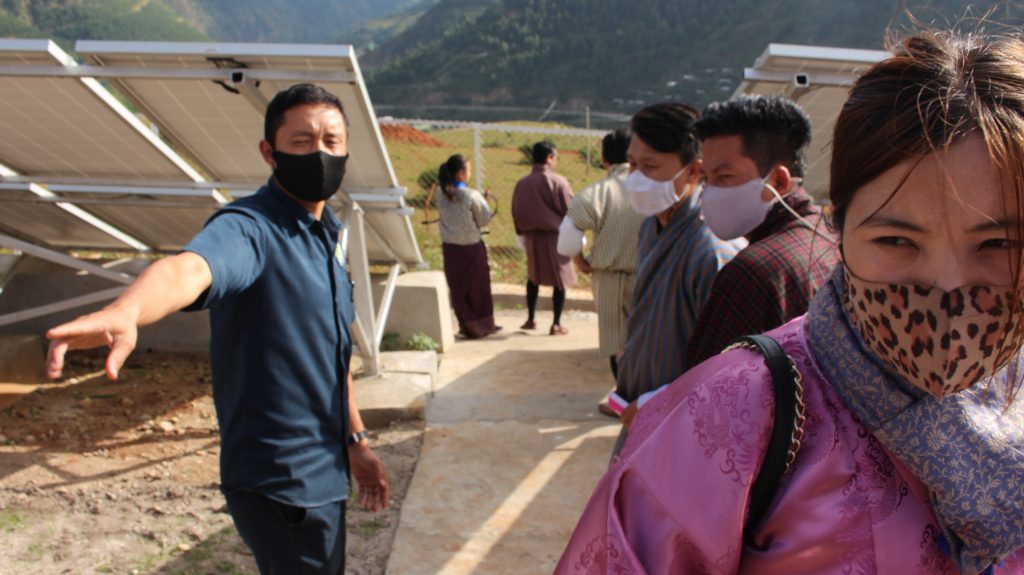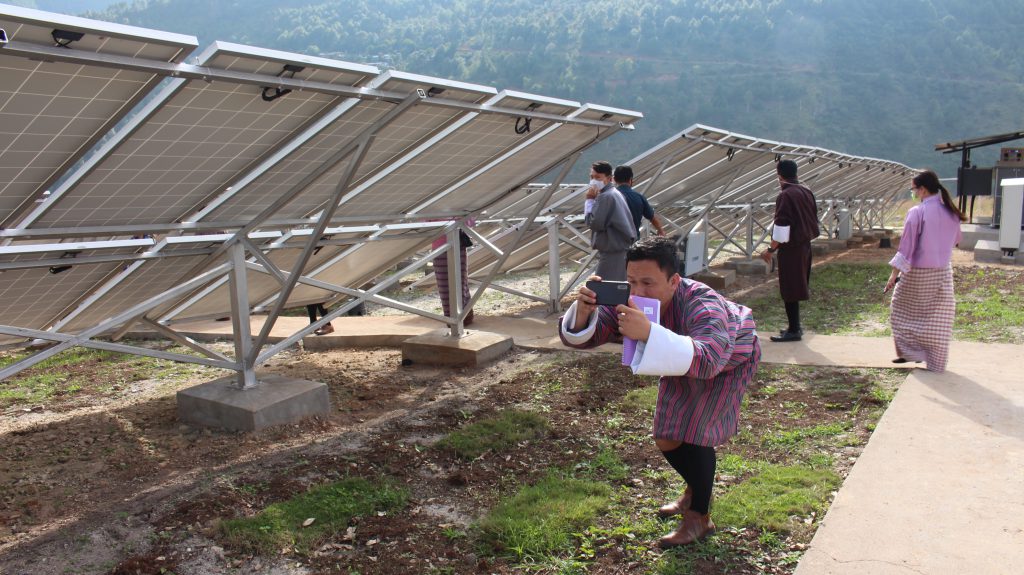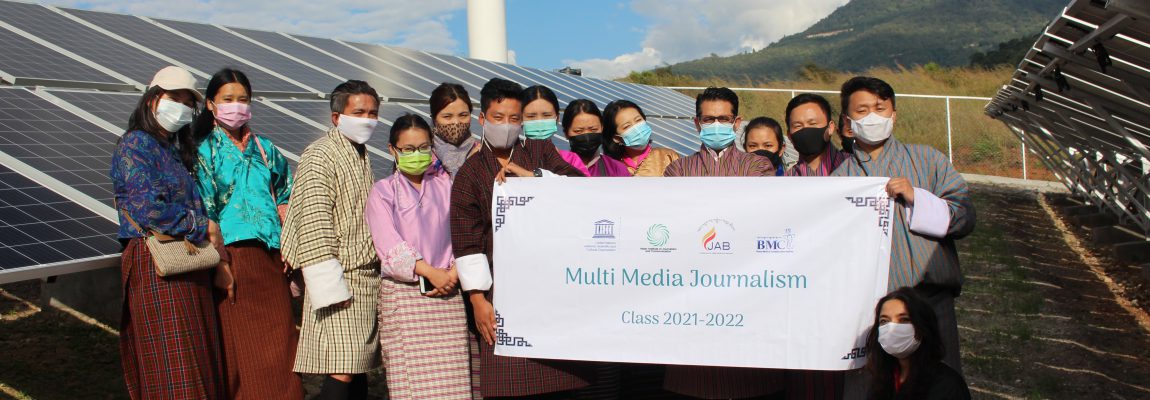A field visit to the Solar and Wind Plant located in Rubesa, Wangduephodrang was made as a part of Multimedia Journalism 2021-2022 training program for 14 trainees led by the trainer of Writing & Reporting module Mr. Gopilal Acharya.
The purpose of the field visit was to write feature story on the first ever renewable source of electricity from Solar and Wind Plant located in Ruebisa, Wangduephodrang. The visit to the plant was also to help trainees gain skills in covering/approach the news through observations and interviews than just covering events in its chronological order.
Mr. Wangchuk, Plant Manager presented the background of the Wind and Solar Plant. The grid-tied solar plant was inaugurated on 4th of October 2021. A capacity of 180-kilowatt (KW) with 464 solar panels produced 263,000 units of energy annually.
The Department of Renewable Energy (DRE), in collaboration with Bhutan Power Corporation (BPC) as the implementing agency, executed the USD 210,000 solar project. This was supported by the United Nations Development Programme, through the funds from the government of Japan funded the project. Wind energy was commissioned in 26 January 2016 funded by Asian Development Bank (ADB) amounting to Nu 178mn.
Trainees inquired about the process of construction carried out in the mid of the pandemic.
Mr. Wangchuk shared that for the first time the Bhutanese carried all the works, starting from design, construction, installation, and grid integration. He added that Bhutanese workers have potential given the right adequate amount of training and resources.
Some trainees also asked about the future operations, Mr. Wangchuk shared that the skills and lessons learned from the current project would help build a better solar plant in the upcoming projects.
He informed trainees that the pilot project not only promotes clean energy but it also fulfills the goal of sustainable development by diversifying our energy-base in the country. He then demonstrated on how the energy is calculated and recorded and that followed by a guided tour of the plant.
Trainees also checked on advantages and disadvantages of renewable sources, they were informed of some of drawbacks like the timing, season, weather impact the energy generation.
A discussion on how the advantages of the renewable energy generation in terms environmental impacts and cost offsets the drawbacks ensued.
Points like how important it is for a small country like Bhutan to heavily dependent on Hydropower energy generation to diversify its energy sources, prioritizing other revenue sources and assessing environmental impacts were also discussed.
Mr. Wangchuk also gave an insight on the pre project plans and assessments before establishing wind energy at Rubessa as a pilot project. Three places were identified, Tshimasham at Chukha, Chelela at Paro and Rubessa.
He explained the Plant Load Factor (PLF) determined the energy output from wind energy, for ideal power generation it ought to be 20-40%. PLF calculation techniques were shown which explained how Tshimasham was calculated at 9.6% and Chelela at 9.10%, hence Rubessa was found to be the best site with highest PLF, 23.2%.
Mr. Wangchuk shared that solar energy can also generates 0.21 mn KWH and the PLF is 19%. He said tariff will be applied soon and once the tariff is applied they will starts generating revenue. Revenue generated will be utilized for the maintenance and development of panels, operational cost will be utilized as staff salary and maintenance cost.
Trainees also asked about the future plans and need for awareness among the general public on the importance of such projects, to which Mr. Wangchuk listed a few projects in the pipeline, Japan International Cooperation Agency (JICA) will fund for solar energy to 300 households across the country for poverty elevation.
Some trainees also asked how the current project benefits the local community, Mr. Wangchuk explained the minimum energy requirement is 2 KW in each household, with 180 KW, they are distributing to 90 households. From wind and solar energy they will be able to distribute to 300 households.
Mr. Wangchuk shared with the trainees that Bhutan Electricity Authority is studying about the tariff for solar and wind energy, after the tariff finalization, revenue generation per annum from Solar and Wind can be exactly calculated, as of now only existing tariff rate is available from Hydro power energy.
Along with the interactive session the trainees and the trainer reflected on the topics learned and related it to journalism such as incorporating use of data while covering stories and going beyond just reporting on the figures or numbers.
Some of the trainees came up with features story idea such as energy security for Bhutan, sustainable power generation and Bhutan’s ability to adapt to newer ways to generate electricity.
Two stories covered by the MMJ trainees were published by Bhutan Times and Bhutan Today, private print media houses in Thimphu.
- http://www.bhutantoday.bt/first-ever-solar-power-project-solely-executed-by-locals/
- https://bhutantimes.bt/index.php/2021/10/18/tapping-bhutans-vast-solar-energy-reserves/
Testimonials from participants
Chhimi Dema – ‘If the Field Trip was longer than just a hald day event, we would have been able to interact with community people and found different story angles, over the trip was good and the journey was fun as we could interact more with each other’
Deki Choden ‘The trip was fun and the experience was new for me, I wish we had more time so I could have gotten more stories ideas’
Sherab Dorji ‘The trip was enjoyable, the plant site was senic’
Tenzin Choden ‘The trip was useful as we can explore the possibility of publishing the story of the plant in our newspaper’
We would like to thank Department of Renewable Energy ,Ministry of Economic Affairs for making it possible. #MMJ#BMCItrainings#futurereadyskills#multimediaskills#journalism#mediaconvergance
With support from UNESCO-IPDC UNESCOAsian Institute of Journalism and Communication@journalist_association
